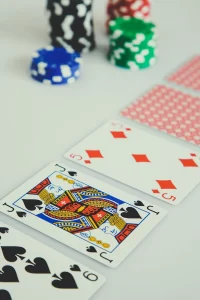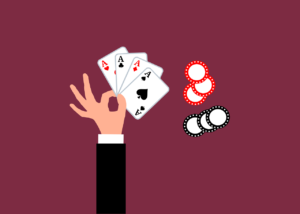Mastering Poker Table Talk: The Art of Verbal and Non-Verbal Communication is a guidebook for poker players who want to improve their communication skills at the table. The book covers both verbal and non-verbal communication techniques that can help players read their opponents and convey information effectively. By mastering these skills, players can gain an edge in the game and improve their chances of winning.
The Importance of Verbal Communication at the Poker Table
First and foremost, verbal communication is essential in poker because it allows you to gather information about your opponents. By listening to what they say and how they say it, you can gain valuable insights into their thought processes, emotions, and tendencies. For example, if an opponent is talking a lot and seems nervous, they may be bluffing. On the other hand, if they’re quiet and reserved, they may have a strong hand.
Verbal communication can also be used to mislead your opponents. By saying one thing and doing another, you can create confusion and uncertainty in their minds. For example, if you have a weak hand, you might say something like “I’m all in” to make your opponents think you have a strong hand. This can cause them to fold, giving you the pot.
However, it’s important to remember that verbal communication is a two-way street. Your opponents are also listening to what you say and how you say it. Therefore, it’s crucial to be mindful of your own verbal cues and to use them strategically. For example, if you have a strong hand, you might speak confidently and assertively to intimidate your opponents.
Non-verbal communication is also an essential aspect of poker. Your body language, facial expressions, and gestures can reveal a lot about your hand and your intentions. For example, if you’re nervous, you might fidget or avoid eye contact. If you have a strong hand, you might sit up straight and make direct eye contact with your opponents.
However, it’s important to be aware of your non-verbal cues and to avoid giving away too much information. For example, if you have a weak hand, you might try to act confident to bluff your opponents. But if you overdo it, you might give away your bluff and lose the pot.
In addition to verbal and non-verbal communication, timing is also crucial in poker. Knowing when to speak and when to stay silent can be the difference between winning and losing. For example, if you have a strong hand, you might wait until the last minute to make a bet, hoping to entice your opponents to raise the stakes. On the other hand, if you have a weak hand, you might fold early to avoid losing more money.
In conclusion, mastering poker table talk is an essential skill for any serious poker player. Verbal and non-verbal communication can provide valuable insights into your opponents’ hands and intentions, while also allowing you to mislead and intimidate them. However, it’s important to be mindful of your own verbal and non-verbal cues and to use them strategically. With practice and patience, you can become a master of poker table talk and increase your chances of success at the poker table.
Mastering Non-Verbal Cues in Poker: What Your Body Language Says
First and foremost, it is essential to understand that your body language can give away a lot about your hand. For example, if you have a strong hand, you may sit up straighter, breathe more deeply, or even smile. Conversely, if you have a weak hand, you may slouch, fidget, or avoid eye contact. These subtle cues can be picked up by observant opponents, who can use them to make informed decisions about their own play.
To avoid giving away too much information, it is crucial to maintain a consistent demeanor throughout the game. This means controlling your body language, regardless of the strength of your hand. One way to do this is to adopt a neutral posture and facial expression. This can be achieved by sitting up straight, keeping your hands still, and avoiding excessive movements or gestures. By doing so, you can prevent your opponents from reading too much into your body language and making incorrect assumptions about your hand.
Another important aspect of non-verbal communication in poker is the use of eye contact. Eye contact can be a powerful tool in poker, as it can convey confidence, strength, and even intimidation. However, it can also reveal nervousness, uncertainty, or even deception. As such, it is essential to use eye contact strategically and selectively.
When playing poker, it is generally best to maintain eye contact with your opponents when you are confident and have a strong hand. This can help to convey a sense of dominance and control, which can make your opponents more likely to fold or make mistakes. Conversely, when you have a weak hand or are uncertain about your play, it is best to avoid eye contact or even look away. This can help to conceal your emotions and prevent your opponents from reading too much into your body language.
In addition to body language and eye contact, there are other non-verbal cues that can reveal information about your hand. For example, the way you handle your chips can indicate whether you are confident or nervous. If you stack your chips neatly and confidently, it can suggest that you have a strong hand. Conversely, if you fumble with your chips or stack them haphazardly, it can suggest that you are uncertain or nervous.
Similarly, the way you handle your cards can also reveal information about your hand. If you hold your cards tightly and close to your chest, it can suggest that you have a strong hand. Conversely, if you hold your cards loosely or expose them accidentally, it can suggest that you have a weak hand or are inexperienced.
In conclusion, non-verbal communication is a crucial aspect of poker that can give you a significant edge over your opponents. By mastering the art of body language, eye contact, and other non-verbal cues, you can convey confidence, strength, and control, while concealing your emotions and intentions. However, it is essential to use these techniques strategically and selectively, as overuse or misuse can give away too much information and lead to costly mistakes. With practice and patience, you can become a master of non-verbal communication in poker and take your game to the next level.
The Psychology Behind Effective Poker Table Talk
The first thing to understand is that poker is a social game. Players interact with each other throughout the game, and the way they communicate can reveal a lot about their hand and their intentions. This is where the psychology behind effective poker table talk comes into play.
Verbal communication is an essential aspect of poker table talk. The way you speak, the words you use, and the tone of your voice can all convey information to your opponents. For example, if you speak confidently and assertively, your opponents may assume that you have a strong hand. On the other hand, if you speak hesitantly or nervously, they may assume that you are bluffing.
It’s important to be aware of your own verbal cues and to pay attention to your opponents’ verbal cues as well. If you notice that a player is speaking more than usual or using certain words repeatedly, it could be a sign that they are trying to deceive you. Similarly, if a player suddenly becomes quiet or stops talking altogether, it could be a sign that they have a strong hand.
Non-verbal communication is another crucial aspect of poker table talk. The way you sit, the way you hold your cards, and the way you look at your opponents can all convey information. For example, if you sit up straight and hold your cards close to your chest, it could be a sign that you have a strong hand. If you look directly at your opponents when they speak, it could be a sign that you are trying to intimidate them.
Again, it’s important to be aware of your own non-verbal cues and to pay attention to your opponents’ non-verbal cues as well. If you notice that a player is fidgeting or looking around the room, it could be a sign that they are nervous or unsure of their hand. Similarly, if a player suddenly becomes very still or avoids eye contact, it could be a sign that they have a strong hand.
One of the most important things to remember about poker table talk is that it’s not just about what you say or how you look. It’s also about what you don’t say and how you don’t look. For example, if you have a weak hand, you may want to avoid looking at your opponents or speaking too confidently. Instead, you may want to appear nervous or unsure to try to convince them that you are bluffing.
In conclusion, mastering the art of verbal and non-verbal communication at the poker table can give you a significant advantage over your opponents. By paying attention to your own cues and your opponents’ cues, you can gain valuable information about their hand and their intentions. Remember, it’s not just about what you say or how you look. It’s also about what you don’t say and how you don’t look. With practice and awareness, you can become a master of poker table talk and take your game to the next level.
How to Use Table Talk to Your Advantage in Poker
Table talk refers to the verbal and non-verbal communication that takes place at the poker table. It includes everything from the words you say to the way you hold your cards. Understanding how to use table talk to your advantage can help you read your opponents, control the pace of the game, and influence the outcome of hands.
One of the most important aspects of table talk is reading your opponents. Paying attention to their words, tone, and body language can give you valuable information about their hand and their mindset. For example, if an opponent is talking a lot and seems nervous, they may be bluffing. On the other hand, if they are quiet and focused, they may have a strong hand.
Another way to use table talk to your advantage is to control the pace of the game. If you’re in a hurry to play a hand, you can speed up the game by talking quickly and making quick decisions. Conversely, if you want to slow down the game and make your opponents uncomfortable, you can take your time and engage in small talk.
Table talk can also be used to influence the outcome of hands. For example, if you have a weak hand but want to stay in the game, you can use verbal cues to make your opponents think you have a stronger hand than you do. You can also use non-verbal cues, such as holding your cards tightly or looking confident, to make your opponents think you have a strong hand.
However, it’s important to remember that table talk can also work against you. If you’re not careful, you can give away valuable information about your hand or your strategy. For example, if you talk too much about a particular hand, your opponents may be able to deduce what cards you have. Similarly, if you act too confident or too nervous, your opponents may be able to read your hand.
To avoid giving away too much information, it’s important to be strategic with your table talk. Only say what you need to say and avoid giving away any unnecessary information. Be aware of your body language and try to remain calm and composed, even if you have a strong hand.
In addition to verbal and non-verbal communication, table talk also includes the use of poker jargon and slang. Understanding these terms can help you communicate more effectively with your opponents and gain a better understanding of the game. Some common poker terms include “bluff,” “call,” “raise,” and “fold.”
Overall, mastering the art of table talk is an essential skill for any serious poker player. By understanding how to read your opponents, control the pace of the game, and influence the outcome of hands, you can gain an edge over your opponents and increase your chances of winning. However, it’s important to be strategic with your communication and avoid giving away too much information. With practice and patience, you can become a master of poker table talk and take your game to the next level.
Common Mistakes to Avoid When Communicating at the Poker Table
The first mistake that many players make is talking too much. While it’s important to be friendly and engage in conversation with your opponents, you don’t want to give away too much information. Talking too much can reveal your thought process, your hand strength, and your overall strategy. It’s important to strike a balance between being friendly and being strategic. If you find yourself talking too much, try to focus on listening more and only speaking when necessary.
Another common mistake is being too aggressive or confrontational. While it’s important to assert yourself and stand up for your hand, you don’t want to come across as hostile or intimidating. This can make other players uncomfortable and may even lead to arguments or fights. Instead, try to be assertive but respectful. Use a calm and measured tone of voice, and avoid making personal attacks or insults.
A third mistake that many players make is failing to read their opponents’ body language. Non-verbal communication can be just as important as verbal communication in poker. By observing your opponents’ body language, you can gain valuable insights into their thought process and hand strength. For example, if a player is fidgeting or avoiding eye contact, they may be nervous or unsure of their hand. On the other hand, if a player is sitting up straight and making direct eye contact, they may be confident in their hand. Paying attention to these subtle cues can give you a significant advantage at the poker table.
Another common mistake is failing to control your own body language. Your own non-verbal cues can also reveal information about your hand strength and thought process. For example, if you’re nervous or unsure, you may fidget or avoid eye contact. If you’re confident, you may sit up straight and make direct eye contact. It’s important to be aware of your own body language and try to control it as much as possible. This can help you avoid giving away too much information to your opponents.
Finally, many players make the mistake of being too predictable. If you always act the same way in certain situations, your opponents will quickly catch on and use this to their advantage. For example, if you always bet big when you have a strong hand, your opponents may start to fold more often when you make big bets. To avoid being too predictable, try to mix up your strategy and vary your actions. This can keep your opponents guessing and make it harder for them to read your hand.
In conclusion, communication is a crucial part of poker. By avoiding these common mistakes, you can improve your communication skills and increase your chances of success at the poker table. Remember to strike a balance between being friendly and being strategic, pay attention to both verbal and non-verbal communication, and try to vary your actions to avoid being too predictable. With practice and patience, you can master the art of poker table talk and become a more successful player. The Art of Verbal and Non-Verbal Communication is an essential skill for any serious poker player. Effective communication can help players gain an advantage over their opponents and improve their overall performance at the table. By understanding the nuances of verbal and non-verbal communication, players can better read their opponents and make more informed decisions. Whether playing in a casual game with friends or in a high-stakes tournament, mastering poker table talk is a valuable skill that can lead to greater success at the table.




